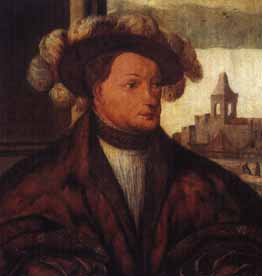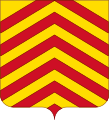Charles II, Duke of Guelders facts for kids
Quick facts for kids
Charles II, Duke of Guelders
|
|
|---|---|

Charles II, Duke of Guelders
|
|
| Born | 9 November 1467 Grave, Netherlands |
| Died | 30 June 1538 (aged 70) Arnhem |
| Noble family | House of Egmond |
| Spouse(s) | Elisabeth of Brunswick-Lüneburg |
| Father | Adolf of Egmond |
| Mother | Catharine of Bourbon |
Charles II (born November 9, 1467 – died June 30, 1538) was an important ruler from the House of Egmond. He was the Duke of Guelders and Count of Zutphen from 1492 until he died. Charles was the son of Adolf of Egmond and Catharine of Bourbon. He played a big part in the Frisian peasant rebellion and the Guelders Wars. These were important conflicts during his time.
Life Story of Charles II
Charles was born in either Arnhem or Grave, Netherlands. He grew up at the court of Charles the Bold, who was the ruler of Burgundy. Charles the Bold had bought the Duchy of Guelders from Charles's father in 1473.
Charles fought in several battles against the armies of Charles VIII of France. In 1487, he was captured during the Battle of Béthune.
Later, King Maximilian gained the Burgundian lands for his family, the Habsburgs, through marriage. In 1492, the people of Guelders were unhappy with Maximilian's rule. They paid money to free Charles from capture and made him their Duke. His aunt, Catherine, helped him rule as his regent.
The French King supported Charles. But in 1505, Maximilian's son, Philip the Handsome, took back Guelders. Charles had to go with Philip to Spain for Philip's coronation as King of Castile. However, Charles managed to escape in Antwerp. Philip died shortly after in Spain. By July 1513, Charles had taken back control of all of Guelders.
Charles was also involved in the Frisian peasant rebellion. He first gave money to the rebel leader, Pier Gerlofs Donia. When the rebels started losing, Charles stopped his support. He then switched sides along with his military leader, Maarten van Rossum.
In 1528, a peace agreement called the Treaty of Gorinchem was made. Emperor Charles, who was Philip the Handsome's son, offered to recognize Charles of Egmond as Duke of Guelders. This was on one condition: if Charles died without children, the Duchy would go to Emperor Charles. At that time, Charles of Egmond did not have any children. He waited to sign the treaty. Another battle happened, and then that condition was removed from the treaty. Finally, in 1536, Guelders and Burgundy made peace with the Treaty of Grave.
Charles died in Arnhem. He is buried in the St. Eusebius Church there.
Family Life
In 1519, Charles married Elisabeth of Brunswick-Lüneburg (1494–1572). They did not have any children together. However, Charles did have several children outside of his marriage.
His only sister, Philippa (1467–1547), was his twin. She lived longer than him. She died when her great-grandson, Charles III, Duke of Lorraine (1543–1608), was ruling.
Images for kids
See also
 In Spanish: Carlos de Egmond para niños
In Spanish: Carlos de Egmond para niños



